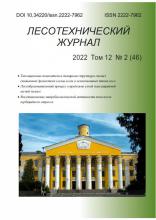Voronezh, Russian Federation
The article proposes to develop a conceptual approach to the prediction of forest fires. The issue on the impact of temperature changes during the year on the accumulation of moisture in the forest litter is considered. Equation for estimating the relative change of water reserve in the litter depending on the ambient temperature relative change is obtained. It is shown that the availability of winter thaws promotes the accumulation of moisture in the soil and the absence of a thaw in the winter can cause to the consolidation of moisture only on the surface in the form of snow or ice. It is increasing probability of moisture loss after a large spring snow melting and provides grounds for the forecast of increasing the risk of forest fire danger in the summer. The effect of temperature distribution along the radius of the trunk of woody plants in the processes of moisture transfer is considered. It is shown that an electric fields arise in tree trunks in the direction along the radius and along the axis of the tree trunk from exposure of nonuniform temperature field. This fact allows speaking about presence of an electrical mechanism of moisture transfer in the pores of the trunks of woody plants. This mechanism coexists with other mechanisms of sap flow in the summer months because of the existence of temperature difference at the change of day and night. If the tempera-ture of the day and night are almost identical, then the electrical mechanism of moisture redistribution in the stems of woody plants stops, and the risk of fire increases. Monitoring of the temperature distribution in the litter and in the trunks of woody plants using digital sensors with controlled accuracy will predict the likelihood of forest fires in advance.
the monitoring of fire danger, the ambient temperature changes, the thermal polarization phenomena, an electrical mechanism of water transport.
1. Castelli, M. Predicting Burned Areas of Forest Fires: an Artificial Intelligence Ap-proach [Text] / Mauro Castelli, Leonardo Vanneschi, and Aleš Popovič. Fire Ecology. - 2015. - Vol. 11, Iss. 1. - pp. 106-118. DOI:https://doi.org/10.4996/fireecology.1101106. EDN: https://elibrary.ru/ZEJGBH
2. Nelson Ralph M. Entrainment regimes and flame characteristics of wildland fires [Text] / Nelson Ralph M., Butler Bret W., Weise David R.. International Journal of Wildland Fire. - 2012. - no. 21 (2). - pp. 127-140. http://dx.doi.org/10.1071/WF10034
3. Perminov, V. Mathematical Modeling of Crown Forest Fire Spread [Text] / Valeriy Perminov. Open Journal of Forestry. - 2012. - Vol. 2. - no. 1. - pp. 17-22. http://dx.doi.org/10.4236/ojf.2012.21003
4. Morvan, D. Modeling of fire spread through a forest fuel bed using a multiphase formula-tion [Text] / D. Morvan, J.L. Dupuy. Combustion and Flame. - 2001. - Vol. 127. - Iss. 1-2. - pp. 1981-1994. DOIhttps://doi.org/10.1016/S0010-2180(01)00302-9. EDN: https://elibrary.ru/ASCIPV
5. Martell, D.L. A Markov Chain Model of Day to Day Changes in the Canadian Forest Fire Weather Index [Text] / D.L. Martell. International Journal of Wildland Fire. - 1999. - no. 9 (4). - pp. 265-273. http://dx.doi.org/10.1071/WF00020
6. Il´ina, V.N. Nekotorye prichiny i itogi lesnykh pozharov na territorii Evropeyskoy chasti Rossiyskoy Federatsii v 2010 godu [Tekst] / V.N. Il´ina. Samarskaya Luka: problemy regional´noy i global´noy ekologii. - 2012. - T. 21. - № 2. - S. 175-183. EDN: https://elibrary.ru/QIWPMB
7. Sofronova, T.M. Otsenka pozharnoy opasnosti po usloviyam pogody v gornykh lesakh Yuzhnogo Pribaykal´ya [Tekst] / T.M. Sofronova, A.V. Volokitina, M.A. Sofronov. Geogra-fiya i prirodnye resursy. - 2008. - № 2. - S. 74-80. EDN: https://elibrary.ru/JULSUB
8. Grishin, A.M. Modelirovanie i prognoz ekologicheskikh katastrof [Tekst] / A.M. Grishin. Ekologicheskie sistemy i pribory. - 2001. - № 2. - S. 12-21.
9. Vonskiy, S.M. Opredelenie prirodnoy pozharnoy opasnosti v lesu [Tekst] : metodicheskie rekomendatsii / S.M. Vonskiy, V.A. Zhdanko, V.I. Korbut. - L.: LenNIILKh, 1981. - 52 s.
10. Kamalova, N.S. Otsenka vliyaniya fluktuatsiy temperatury na pozharobezopasnost´ lesnykh massivov [Tekst] / N.S. Kamalova, N.Yu. Evsikova, V.I. Lisitsyn, V.V. Saushkin. Aktual´nye napravleniya nauchnykh issledovaniy XXI veka: teoriya i praktika : sbornik nauchnykh trudov po materialam mezhdunarodnoy zaochnoy nauchno-prakticheskoy konferentsii. - Voronezh, 2014. - № 3, ch. 4 (8-4). - S. 69-72. DOI: https://doi.org/10.12737/4340; EDN: https://elibrary.ru/SHVQTD
11. Termopolyarizatsionnyy mekhanizm sokodvizheniya v period vesennego ravnodenst-viya [Tekst] / N.N. Matveev, N.S. Kamalova, N.Yu. Evsikova, V.I. Lisitsyn. Lesotekhnicheskiy zhurnal. - 2014. - T. 4. - № 4 (16). - S. 26-36. DOI: https://doi.org/10.12737/8436; EDN: https://elibrary.ru/TONCSD
12. Gridneva, I.V. Issledovanie transporta vody v stvolakh drevesnykh rasteniy metodom matematicheskogo modelirovaniya [Tekst] / I.V. Gridneva, N.S. Kamalova, N.Yu. Evsikova. Vestnik Voronezhskogo gosudarstvennogo agrarnogo universiteta. - 2015. № 1 (44). - S. 58-64. EDN: https://elibrary.ru/TYYUYN












